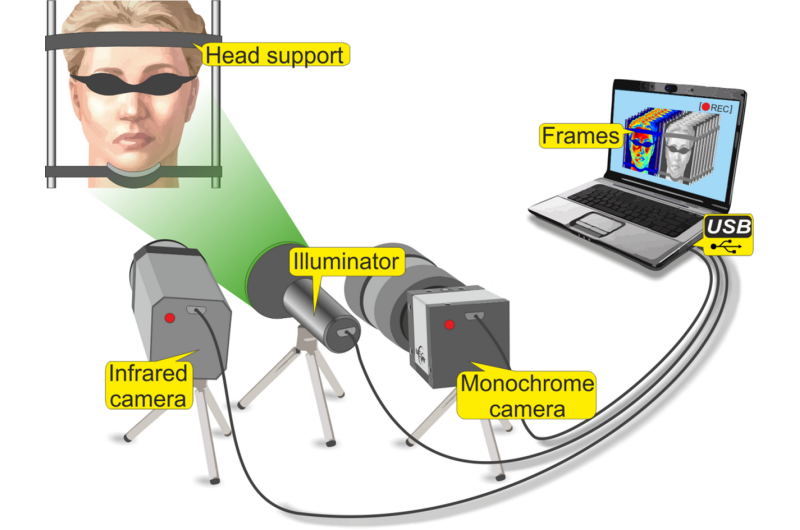Credit: ITMO University
A group of scientists from several Russian universities and medical centers have proposed a new explanation of the nature of migraine, one of the most ancient neurologic conditions. The study was conducted within a larger project to develop a device capable of remotely and effectively diagnosing migraine. The scientists found that patients with migraine differ from healthy people by increased vascular reactivity, which is commonly expressed in more frequent constriction and extension of arterial walls than usual. At the same time, cardiac regulation was equal in both groups. The results were published in the Journal of Headache and Pain.
Most people suffer from occasional headaches. However, in the majority of cases, a painkiller is sufficient to relieve pain. Migraine patients are not so lucky. These people suffer from chronic headaches that cannot be relieved by pills. Additionally, migraine is often accompanied by nausea, vomiting, vision problems, increased sensitivity and can last up to several days, which negatively affects the quality of life.
Today, there is no consensus among scientists on the mechanisms of this disease. Therefore, no truly effective drugs exist that can completely relieve migraine.
A Russian research collaborative decided to consider migraine as a result of disorders in the cardiovascular system rather than in the nervous system. To this end, the researchers conducted a number of tests to estimate autonomic (vasomotor) regulation of blood circulation. A group of 73 patients suffering from migraine and 71 healthy persons around 35 years old were invited for the study.
The researchers evaluated a broad range of cardiac parameters, many of which, as it turned out, do not have any influence on the presence of migraine. "Cardiac regulation is the same in both groups," says Oleg Mamontov, lead author of the study and a senior researcher at the Department for Cardiovascular Physiology at Almazov Centre. "However, we have observed that patients with migraine have increased vasomotor reactivity of blood vessels that is consistent with the findings of a number of similar studies."
Vascular reactivity is a broad concept. It includes not only vascular tone, but also more complex metabolic and neuro-regulatory processes within vessels. The increased vascular reactivity is most commonly observed in spasms of the arteries.
All blood vessels bind with the nervous system, which controls their contraction. The nervous system harmoniously transmits the pulsations throughout the body. If for some reason, this coherence is violated, serious disorders may arise; according to the scientists, one such disorder can be migraine.
The reactivity of blood vessels can also be evaluated based on the response of the organism to the external environment. "For the first time, we used the method of occlusion plethysmography to assess migraine patients. This method has shown the biggest deviations in patients with frequent and chronic migraine (attacks that last more than 14 days per month). Using this test, we have studied how the musculocutaneous vessels respond to low temperature stress," notes Oleg Mamontov.
Credit: ITMO University
The occlusion plethysmography is widely used to diagnose diseases related to the tone of the cardiovascular system. During the measurements, the researchers block veins in some part of the body and record the increase in size of the limb over time. This makes it possible to define various parameters of blood flow. But this method is associated with some discomfort for the patient. Thus, the study devoted to the nature of migraine was a part of a larger project to create an optical device to non-invasively diagnose circulatory disorders.
When blood is pulsating in a living body, light reflection from the skin also changes. This change is especially noticeable on the blushing cheeks of someone who goes from a warm environment to a colder one. "Subtle shifts invisible to our eyes can be monitored with an ordinary camera and then processed with special software," says Alexei Kamshilin, senior researcher at ITMO University. "This technique is called imaging photoplethysmography, and it can help us determine the difference in pulsation of the arteries which fill the brain with blood, and perhaps diagnose migraine."
For instance, it is known also that in most cases, only one half of the brain hurts during the migraine attack, and sometimes the pain goes from one half to the other. Such "migration" may be associated with the fact that the brain of migraine patients is unevenly supplied with blood. "The brain of a healthy person is supplied by two simultaneous flows from two arteries – the right and the left," says Alexei Kamshilin. "Our previous experiments have shown that blood pulsations in the right and left arteries of migraine patients occur asynchronously."
Alexei Kamshilin notes that the research team will continue to gather statistical data to improve the significance of the results. "Both the selection of patients and work with them are quite time consuming," says the scientist. "We would get extremely valuable information if we were able to see patients during a migraine attack, but, for obvious reasons, not all people agree."
More information: Oleg V. Mamontov et al. Autonomous control of cardiovascular reactivity in patients with episodic and chronic forms of migraine, The Journal of Headache and Pain (2016). DOI: 10.1186/s10194-016-0645-6
Provided by ITMO University






















